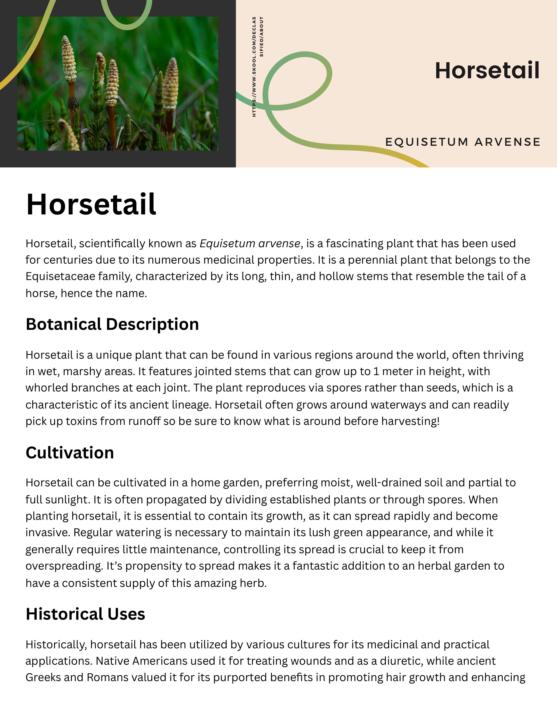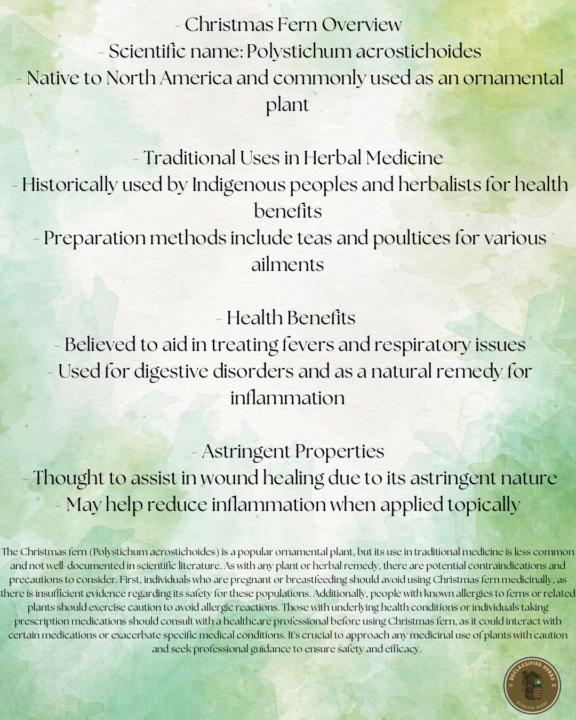Activity
Mon
Wed
Fri
Sun
Jan
Feb
Mar
Apr
May
Jun
Jul
Aug
Sep
Oct
Nov
Dec
What is this?
Less
More
Memberships
Painters Hub
6.4k members • Free
Declassified Herbs
21 members • $10/m
4 contributions to Declassified Herbs
Welcome to New Members!
If you’re new here, please take a moment to introduce yourself and help us get to know you a little bit! If you have some experience with herbal/natural remedies already, feel free to tell us your story! Also let us now what type of information you’re most interested in!
Poll
8 members have voted


Christmas Fern
The Christmas Fern (Polystichum acrostichoides) is a resilient and evergreen fern that thrives in the temperate regions of eastern North America. This plant is particularly cherished for its striking dark green fronds, which maintain their lush appearance throughout the winter months, offering a refreshing burst of greenery when many other plants have withered in the cold. Its evergreen nature makes it easy to spot in the cold snowy winters of Ohio. Historically, the Christmas Fern has played a significant role in the traditional medicine practices of indigenous peoples and early European settlers. They recognized the plant's potential health benefits and utilized it for a variety of medicinal purposes. The fern was commonly used in herbal remedies aimed at treating ailments such as fever, pneumonia, and even heart conditions. Some herbalists believe that the Christmas Fern possesses anti-inflammatory and astringent properties, making it a valuable resource for addressing various health issues. The preparation of the fern for medicinal use often involved brewing its roots and fronds into teas, decoctions or creating a poultice. These preparations were thought to help alleviate respiratory problems, such as coughs and bronchitis, as well as digestive disorders, fevers and minor inflammation. The soothing qualities attributed to the Christmas Fern made it a sought-after ingredient in home remedies for centuries. In contemporary times Christmas Fern retains a niche presence in herbal medicine circles but is a good plant to be aware of due to its abundance and evergreen nature. Herbal gardeners may appreciate it for its ability to thrive in shaded areas and as a ground cover, contributing to a natural landscape as well as an addition to a home apothecary. As with any herbal remedy, caution is advised when considering the Christmas Fern for medicinal use. It is always best to consult healthcare professionals before incorporating it into a treatment regimen, especially for those with pre-existing health conditions or who are taking other medications. While the Christmas Fern holds a place in the history of herbal medicine, a thorough understanding of its properties, benefits, and limitations is essential for safe and effective use.

Dental Care in an Austere or Post-Disaster Environment
In the aftermath of a disaster, access to modern dental care can be severely limited. However, many cultures have historically relied on natural remedies to maintain oral health, particularly herbs, which can be highly effective in a post-disaster environment. This guide explores various herbs used in traditional dental care and their benefits. Herbs for Tooth Care and Oral Health 1. Clove Clove has long been known for its antiseptic and analgesic properties. The active compound, eugenol, is effective in numbing pain and fighting infection. - Uses: Clove oil can be applied directly to a painful tooth or gum using a cotton swab. Whole cloves can also be chewed gently to release their beneficial oils. - Benefits: Pain relief, reduction of inflammation, and antibacterial action. 2. Peppermint Peppermint leaves contain menthol, which has soothing and cooling effects. It is also known for its antimicrobial properties. - Uses: Fresh peppermint leaves can be chewed or brewed into a tea to use as a mouth rinse. - Benefits: Freshens breath, soothes irritated gums, and combats bacteria. 3. Sage Sage is renowned for its antibacterial and astringent properties, making it ideal for maintaining oral health. - Uses: Sage leaves can be rubbed directly onto the teeth and gums or used to make a mouthwash. - Benefits: Helps to clean teeth, reduce gum inflammation, and promote healing. 4. Thyme Thyme contains thymol, a powerful antiseptic that aids in preventing oral infections. - Uses: Thyme can be brewed into a tea for rinses or its essential oil can be diluted and applied to the gums. - Benefits: Antibacterial and antifungal properties help prevent tooth decay and gum disease. 5. Neem Neem twigs have been used for centuries as a natural toothbrush in various cultures. - Uses: Chewing on neem twigs helps clean teeth and eliminate bacteria. - Benefits: Reduces plaque, prevents cavities, and supports overall oral hygiene. 6. Calendula Calendula, or marigold, has anti-inflammatory and healing properties, making it useful for soothing sore gums.
1-4 of 4
@cathleen-w-7092
Entering into the Winter of life, I look at growing old as an adventure & God as my Guide.Hoping with my brushs, 'He will create a Good Work in Me'.
Active 128d ago
Joined Nov 19, 2024
USA
Powered by

